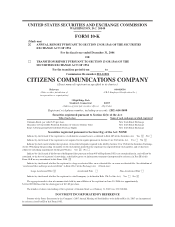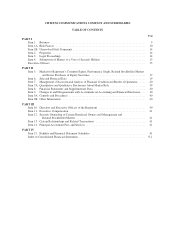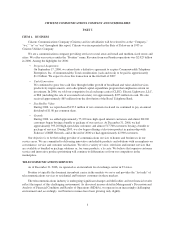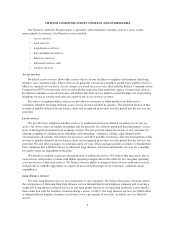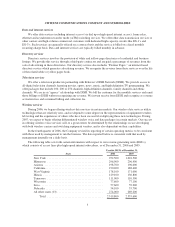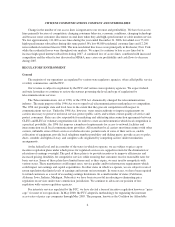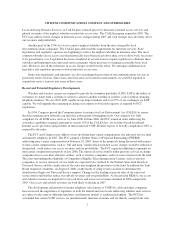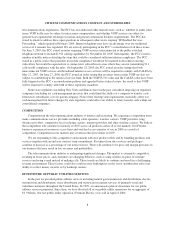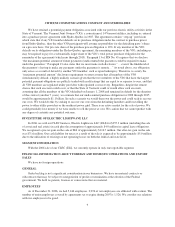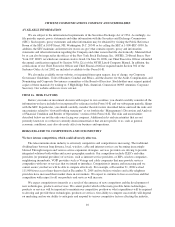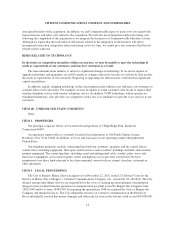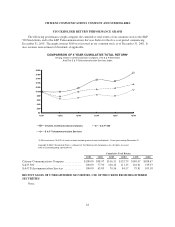Frontier Communications 2006 Annual Report Download - page 10
Download and view the complete annual report
Please find page 10 of the 2006 Frontier Communications annual report below. You can navigate through the pages in the report by either clicking on the pages listed below, or by using the keyword search tool below to find specific information within the annual report.CITIZENS COMMUNICATIONS COMPANY AND SUBSIDIARIES
We have retained a potential payment obligation associated with our previous electric utility activities in the
State of Vermont. The Vermont Joint Owners (VJO), a consortium of 14 Vermont utilities, including us, entered
into a purchase power agreement with Hydro-Quebec in 1987. The agreement contains “step-up” provisions
which state that if any VJO member defaults on its purchase obligation under the contract to purchase power
from Hydro-Quebec, then the other VJO participants will assume responsibility for the defaulting party’s share
on a pro-rata basis. Our pro-rata share of the purchase power obligation is 10%. If any member of the VJO
defaults on its obligations under the Hydro-Quebec agreement, the remaining members of the VJO, including us,
may be required to pay for a substantially larger share of the VJO’s total power purchase obligation for the
remainder of the agreement (which runs through 2015). Paragraph 13 of FIN No. 45 requires that we disclose
“the maximum potential amount of future payments (undiscounted) the guarantor could be required to make
under the guarantee.” Paragraph 13 also states that we must make such disclosure “… even if the likelihood of
the guarantor’s having to make any payments under the guarantee is remote…” As noted above, our obligation
only arises as a result of default by another VJO member, such as upon bankruptcy. Therefore, to satisfy the
“maximum potential amount” disclosure requirement we must assume that all members of the VJO
simultaneously default, a highly unlikely scenario given that the two members of the VJO that have the largest
potential payment obligations are publicly traded with credit ratings that are equal to or superior to ours, and that
all VJO members are regulated utility providers with regulated cost recovery. Regardless, despite the remote
chance that such an event could occur, or that the State of Vermont could or would allow such an event,
assuming that all the members of the VJO defaulted on January 1, 2008 and remained in default for the duration
of the contract (another 7 years), we estimate that our undiscounted purchase obligation for 2008 through 2015
would be approximately $1.1 billion. In such a scenario we would then own the power and could seek to recover
our costs. We would do this by seeking to recover our costs from the defaulting members and/or reselling the
power to other utility providers or the northeast power grid. There is an active market for the sale of power. We
could potentially lose money if we were unable to sell the power at cost. We caution that we cannot predict with
any degree of certainty any potential outcome.
DIVESTITURE OF ELECTRIC LIGHTWAVE LLC
In 2006, we sold our CLEC business, Electric Lightwave LLC (ELI) for $255.3 million (including the sale
of associated real estate) in cash plus the assumption of approximately $4.0 million in capital lease obligations.
We recognized a pre-tax gain on the sale of ELI of approximately $116.7 million. Our after-tax gain on the sale
was $71.6 million. Our cash liability for taxes as a result of the sale is expected to be approximately $5.0 million
due to the utilization of existing tax net operating losses on both the federal and state level.
SEGMENT INFORMATION
With the 2006 sale of our CLEC (ELI), we currently operate in only one reportable segment.
FINANCIAL INFORMATION ABOUT FOREIGN AND DOMESTIC OPERATIONS AND EXPORT
SALES
We have no foreign operations.
GENERAL
Order backlog is not a significant consideration in our businesses. We have no material contracts or
subcontracts that may be subject to renegotiation of profits or termination at the election of the Federal
government. We hold no patents, licenses or concessions that are material.
EMPLOYEES
As of December 31, 2006, we had 5,446 employees. 2,996 of our employees are affiliated with a union. The
number of union employees covered by agreements set to expire during 2007 is 1,526. We consider our relations
with our employees to be good.
9


